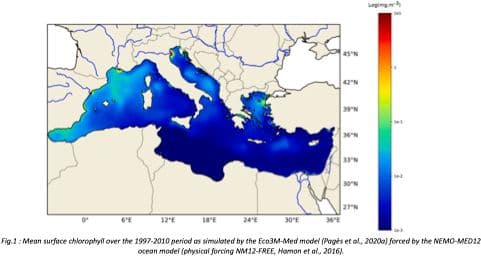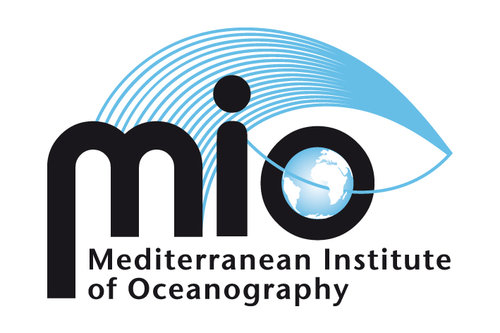Hindcast (1985-2013) of the mediterranean biogeochemistry provided by the NEMO-MED12/Eco3M-MED model (LaSeR-Med project)
"Towards an integrated prediction of Land & Sea Responses to global change in the Mediterranean Basin"
The LaSeR-Med project aims at investigating the effects of climate change and of mediterranean population growth on some major indicators of the Mediterranean Sea (primary production, carbon export, zooplankton biomass available for small pelagic fishes, pH, dissolved oxygen) using and integrated model encompassing a socio-economic model, a continental model of agro-ecosystems, and a physical ocean-atmosphere model coupled to a biogeochemical model of the ocean. Last, a model for the widespread species of jellyfish Pelagia Noctiluca (Berline et al., 2013) uses biogeochemical outputs as food forcing for the jellyfish.
In this project, our first aim was to investigate the large-scale and long-term impacts of variations in river inputs on the biogeochemistry of the Mediterranean Sea over the last decades (see Pages et al., 2020a).
This interdisciplinary project provided the framework for joint discussions on each of the sub-models that constitute the integrated model, namely the socio-economic model (Ami et al., in prep., Mardesic et al., in prep.) created ex nihilo by researchers from AMSE, INRA and GREQAM, the continental agro-ecosystem model LPJmL (Bondeau et al., 2007) worked on at IMBE so as to include the nitrogen and phosphorous cycles in the frame of the present project, and the ocean biogeochemical model Eco3M-Med developed at MIO (Baklouti et al., 2006; Alekseenko et al. 2014, Guyennon et al., 2015; Pagès et al., 2020a), forced by ocean physics, either using the ocean model NEMO-Med12 forced by atmosphere at IPSL (simulation NM12-FREE run with the NEMO-MED12 model and used for our hindcast simulation, see below) or a coupled ocean-atmosphere model at CNRM (physical forcing provided by CNRM-RCSM4, see below).
Details on simulation NM12-free:
The historical simulation used in this work is referred to as the NM12-FREE (no reanalysis no data assimilation) which started in October 1979 and ended in June 2013 (Hamon et al., 2016). It has been run with the general circulation model NEMO in its regional configuration NEMO-MED12 based on a horizontal resolution of 1/12 de degree (6.5 to 8 km cells) and a 75-level vertical resolution (of 1 m width at the surface to 135 m at the seabed).
For this simulation, runoff and river inputs in the NM12 domain came from the inter-annual data of Ludwig et al. (2009) and the atmospheric forcing was based on the dynamical downscaling of the ERA-INTERIM reanalysis, i.e. ALDERA which has a 12 km spatial resolution and a 3 h temporal resolution. More details on the NM12-FREE simulation are given in Hamon et al. (2016).
Keywords:
- Mediterranean Sea, river inputs, chlorophyll, nutrients, phytoplankton, bacteria, zooplankton, dissolved and particulate organic detrital matter
Citation:
Pagès, R., Baklouti, M., Barrier, N., Richon, C., Dutay, J.-C., and Moutin, T. (2020a). Changes in rivers inputs during the last decades significantly impacted the biogeochemistry of the eastern Mediterranean basin: a modelling study. Prog. Oceanogr. 181:102242. doi:10.1016/j.pocean.2019.102242
Ayache, M., Bondeau, A., Pagès, R., Barrier, N., Ostberg, S. and Baklouti, M. (2020). LPJmL-Med – Modelling the dynamics of the land-sea nutrient transfer over the Mediterranean region–version 1: Model description and evaluation. Geoscientific Model Development Discussions, Copernicus Publ.
Simple
- Date (Publication)
- 2021-07-21T10:30:00
- Identifier
- http://dataset.osupytheas.fr/geonetwork/srv/resources6d0faad5-d38c-4d9f-b88e-1ff4325c9ed0
- Purpose
- 3D biogeochemical historical simulation forced by the NEMO-MED12 physical model at the scale of the Mediterranean Sea run in the frame of the LaSeR-Med project
- Status
- Historical archive
- Maintenance and update frequency
- Not planned
- GEMET - Concepts, version 2.4
-
- chlorophyll
- environmental science
- climatic change
- biological process
- biodegradation
- evolution
- modelling
- climatic experiment
- Keywords
-
- Continents, countries, sea regions of the world.
-
- Mediterranean Sea
- Theme
-
- Mediterranean Sea
- river inputs
- chlorophyll
- nutrients
- phytoplankton
- bacteria
- zooplankton
- dissolved and particulate organic detrital matter
- Access constraints
- License
- Use constraints
- otherRestictions
- Other constraints
- In addition to properly cite this dataset, it would be appreciated that the following work(s) be cited too, when using this dataset in a publication : Pagès, R., Baklouti, M., Barrier, N., Richon, C., Dutay, J.-C., and Moutin, T. (2020a). Changes in rivers inputs during the last decades significantly impacted the biogeochemistry of the eastern Mediterranean basin: a modelling study. Prog. Oceanogr. 181:102242. doi:10.1016/j.pocean.2019.102242
- Spatial representation type
- Text, table
- Denominator
- 5000
- Metadata language
- English
- Character set
- UTF8
- Topic category
-
- Oceans
- Environment
- Begin date
- 1985-01-01
- End date
- 2010-12-31
- Description
- Mediterranean Sea
))
- Supplemental Information
- Mediterranean sea
- Reference system identifier
- WGS 1984
- Distribution format
-
-
relationnal database SQL
(
1.0
)
-
relationnal database SQL
(
1.0
)
- Hierarchy level
- Dataset
- Statement
- 3D simulation ran using HPC resources from GENCI-IDRIS ( project 0227)
- File identifier
- 6d0faad5-d38c-4d9f-b88e-1ff4325c9ed0 XML
- Metadata language
- English
- Character set
- UTF8
- Hierarchy level
- Dataset
- Hierarchy level name
- dataset
- Date stamp
- 2022-01-21T12:58:20
- Metadata standard name
- ISO 19115:2003/19139
- Metadata standard version
- 1.0
Overviews


Spatial extent
))
Provided by

 Catalogue PIGMA
Catalogue PIGMA